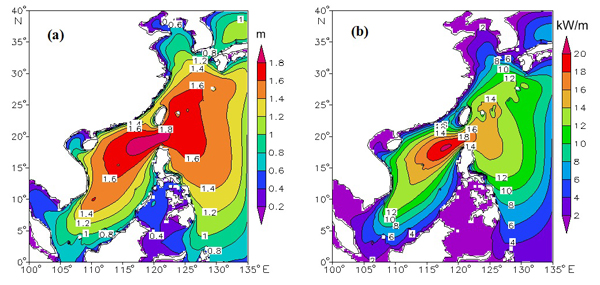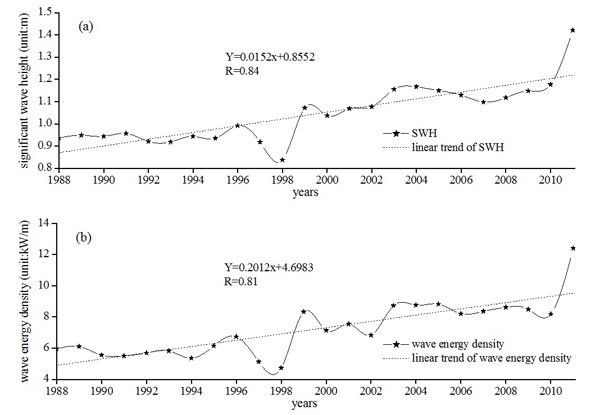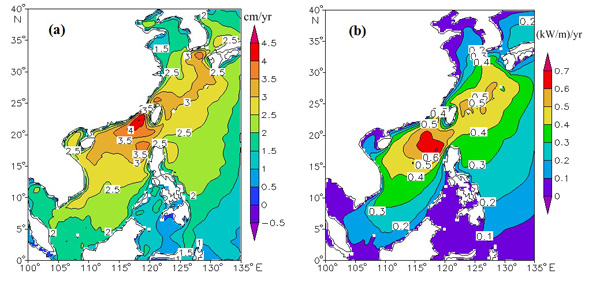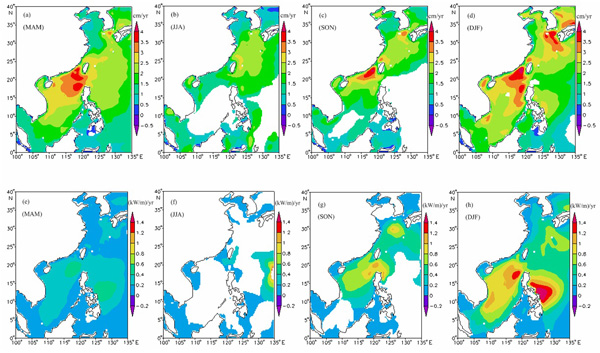State Key Laboratory of Numerical Modeling for Atmospheric Sciences and
Geophysical Fluid Dynamics (LASG)
Institute of Atmospheric Physics, Chinese Academy of Sciences

Vol. 4/No.4 December 2017
[Climate change] Climatic trends in the wave energy and significant wave height of the China seas
Highlights:
There is a noticeable increasing trend in most parts of the China seas, of 0.1-0.7 (kW/m)/yr in wave power density (WPD) and 0.5-4.5 cm/yr in significant wave height (SWH).
There is a noticeable seasonal difference in the variation of both SWH and WPD.
The variations of SWH and WPD in different waters are dominated by the different seasons.
The analysis of variations of SWH and WPD plays a positive in improving the forecasting precision of ocean wave and wave energy.
Given the current background of ongoing environmental and resource issues, the increased exploitation of clean and renewable energy could help to alleviate the energy crisis, as well as contributing to emissions reduction and environmental protection, and so promote future sustainable development. Resource evaluation in advance can make contribution to orderly development of wave energy. Previous researchers have made great contributions to the wave energy resource assessment. However, there is little research about the long term trend of the wave energy.
Academician Li Chong-yin (LASG, Institute of Atmospheric Physics) and Dr. Zheng Chong-wei (Dalian Naval Academy) presented the climatic long term trends in the wave power and significant wave height (SWH) of the China seas for the period 1988-2011, using a WAVEWATCH-III (WW3) hindcast wave data. The regional difference and seasonal difference of the variation are also presented firstly. Results show that the China Sea exhibits a significant overall increasing trend in the wave power density (0.2012 (kW/m)/yr) and the SWH (1.52 cm/yr) for the period 1988 to 2011. There is a noticeable increasing trend in most parts of the China Sea, of 0.1-0.7 (kW/m)/yr in wave power density and 0.5-4.5 cm/yr in SWH. Areas with strong increasing trend distribute in the Ryukyu Islands waters, Taiwan Strait and north of the South China Sea (SCS), especially in the Dongsha Islands waters. There is a noticeable seasonal difference in the variation of both SWH and wave power density. The variation in different waters is dominated by the different seasons. The increasing trend of SWH in DJF and MAM is obviously stronger than that in JJA and SON. The increasing trend of wave power density in DJF is stronger than that in other seasons. The results play a positive role in the wave power plant selection, long term plan of wave energy development and analysis of global climate change.
This research findings have been published in Renewable and Sustainable Energy Reviews.

Figure 1. Annual average significant wave height (a) and wave power density (b) in the China seas.

Figure 2. Long term trends of the China seas SWH (a) and wave power density (b) with regional average.

Figure 3. Long term trends of significant wave height (a) and wave power density (b) in the China seas.
Only area significant at 95% level is presented.

Figure 4. Long term trends of significant wave height (a-d) and wave power density (e-h) in MAM (March, April, May), JJA (June, July, August), SON (September, October, November) and DJF (December, January, February) in the China seas. Only area significant at 95% level is presented.
Citation:
Zheng Chong-wei, Li Chong-yin. Variation of the wave energy and significant wave height in the China Sea and adjacent waters Renewable and Sustainable Energy Reviews, 2015, 43: 381–387.
Download: http://dx.doi.org/10.1016/j.rser.2014.11.001
Zheng Chong-wei, Wang Qing, Li Chong-yin. An overview of medium- to long-term predictions of global wave energy resources. Renewable and Sustainable Energy Reviews, 2017, 79: 1492–1502, doi: http://dx.doi.org/10.1016/j.rser.2017.05.109
Download: http://dx.doi.org/10.1016/j.rser.2017.05.109
Contact:
Li Chong-yin, lcy@lasg.iap.ac.cn; Zheng Chong-wei, chinaoceanzcw@sina.cn
E-mail: lasg_newsletter@lasg.iap.ac.cn
Editors: Chuanyi Wang (wangcy@lasg.iap.ac.cn), Kangjun Chen(ckj@lasg.iap.ac.cn)